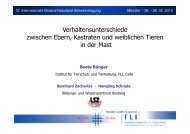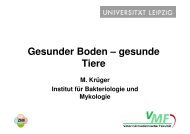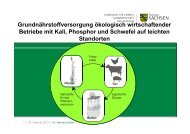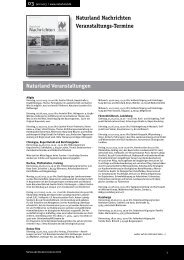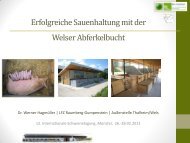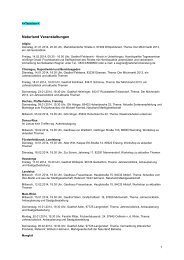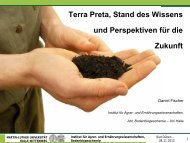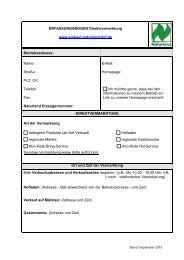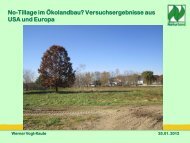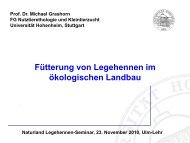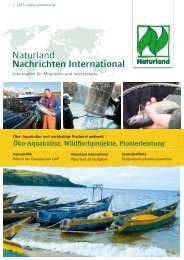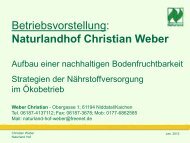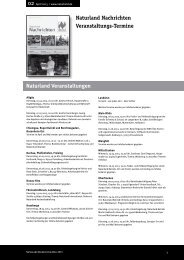Organic Farming in the Tropics and Subtropics: Sesame - Naturland
Organic Farming in the Tropics and Subtropics: Sesame - Naturland
Organic Farming in the Tropics and Subtropics: Sesame - Naturland
You also want an ePaper? Increase the reach of your titles
YUMPU automatically turns print PDFs into web optimized ePapers that Google loves.
II Special section: <strong>Organic</strong> Cultivation of <strong>Sesame</strong><br />
Bacterial germs Regulation measures<br />
Pseudomonas syr<strong>in</strong>gae pv.<br />
sesami<br />
(Bacterial Leaf Spot)<br />
Xanthomonas campestris<br />
pv.sesami<br />
(Bacterial blight)<br />
Viruses Regulation measures<br />
Nicotiana 10 virus<br />
(Leaf Curl)<br />
Phyllody<br />
“Mycoplasma-like-organism”<br />
(MLO)<br />
2.6.2. Pests <strong>and</strong> methods of combat<strong>in</strong>g <strong>the</strong>m<br />
Dress seeds <strong>in</strong> hot water: 10 m<strong>in</strong>. at 52°C.<br />
Transmission by seeds possible for 11 months. Use<br />
resistant varieties. Cultivate at low humidity <strong>and</strong><br />
temperature (change sow<strong>in</strong>g date).<br />
Dress seeds <strong>in</strong> hot water: 10 m<strong>in</strong>. at 52°C. Identify<br />
resistance by <strong>in</strong>fect<strong>in</strong>g seedl<strong>in</strong>gs. Transmission<br />
through <strong>the</strong> soil, only for 4-6 months, via seeds, for up<br />
to 16 months. Also transmitted via field weed<br />
Acanthospermum hisdidum. Cultivate at low humidity<br />
<strong>and</strong> temperature (change sow<strong>in</strong>g date).<br />
Use resistant varieties. Has many host plants e.g..<br />
tobacco, tomato, papaya <strong>and</strong> is also transmitted by <strong>the</strong><br />
white fly Bemisia tabaci.<br />
Select sow<strong>in</strong>g date at low vector population.<br />
Vectors: leafhoppers (Homoptera) Orosius albic<strong>in</strong>ctus.<br />
Use resistant varieties, which blossom with<strong>in</strong> 40-50<br />
days.<br />
Important measures to prevent a massive <strong>in</strong>festation of pests<br />
• Encourage natural antagonists (e.g. create an eco-system with trees, hedges,<br />
mixed crops, avoid slash <strong>and</strong> burn).<br />
• Crop rotation – which excludes host plants.<br />
• Mixed cultivation to diversify <strong>the</strong> agroeco-system, This will disorientate some<br />
pests <strong>and</strong> encourage antagonists. Example: In a mixed crop system with sesame<br />
<strong>and</strong> mungo or Phaseolus beans, <strong>the</strong> beans will be <strong>in</strong>fected by bugs, leav<strong>in</strong>g <strong>the</strong><br />
sesame capsules relatively untouched 15 .<br />
• Sow yellow flowers near to <strong>the</strong> sesame field, e.g. sunflowers <strong>and</strong> calendula. The<br />
colours will attract pests, which can <strong>the</strong>n be dealt with.<br />
• Remove harvest rema<strong>in</strong>s <strong>and</strong> host plants 16 17 (also <strong>in</strong> <strong>the</strong> vic<strong>in</strong>ity of <strong>the</strong> field) such as:<br />
a) Common amaranth Amaranthus retroflexus<br />
b) Wax bean Phaseolus ssp.<br />
c) Ipomoea spp.<br />
d) Bidens pilosa<br />
e) Thitonia rotundifolia<br />
15<br />
CLUSA (1995): Producción orgánica de ajonjolí. Serie de documentos técnicos, Managua.<br />
16<br />
AGRODESA (1997): Manual de ajonjolí orgánico. San Salvador.<br />
17<br />
CLUSA (1995): Producción orgánica de ajonjolí. Serie de documentos técnicos, Managua.<br />
Naturl<strong>and</strong> e.V. – 1 st edition 2000 Page 12



